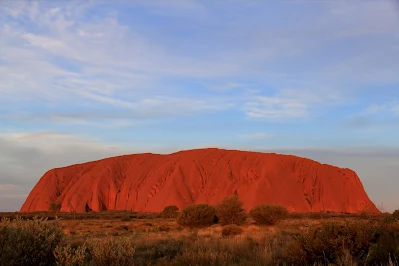Uluru, previously known as Ayers Rock, isn't just a massive stone in the vast expanse of Australia's outback; it's a beacon calling travellers from around the globe to experience its majesty. While Uluru itself mesmerises every onlooker, finding the perfect accommodation at Uluru can elevate this awe-inspiring adventure. Whether you're leaning towards the comfort of hotels, the allure of camping under the stars, or the luxury of a resort, Uluru’s accommodations cater to every narrative, making it a pivotal part of your journey.
Diving deeper into accommodation Uluru, the options are as diverse as the landscape, blending seamlessly with stories of the past and present. This comprehensive guide aims to navigate through the myriad of choices, from rustic camping spots that let you be one with nature to plush resorts that offer a view of the rock as you’ve never seen it before. Stick with me, and together, we'll discover how to make your stay as monumental as the rock itself.
The Geographical Marvel of Uluru
Diving into the heart of the Australian outback, Uluru stands as a testament to the earth's ancient history and nature's artistry. Here's a glimpse into the geographical marvel that Uluru embodies:
Formation and Age: Believe it or not, Uluru is approximately 500 million years old, sharing its birthday with the Australian continent itself. This massive sandstone monolith didn't just pop up overnight; it was formed underwater by the pressure of tectonic plates shifting, squeezing together two fans of sand and conglomerate rock. As Australia's landscape dried up, Uluru was exposed in all its glory.
Unique Features:
- Erosion's Artwork: The southern side showcases steep valleys and large pot-holes, sculpted by centuries of water erosion on arkose rock . Meanwhile, the north-west side flaunts parallel ridges, a testament to the relentless work of strong winds and rainfall.
- Human Touch: The smoother sections of Uluru owe their texture to the millions of feet that have traversed its surface, wearing it down over time. However, since October 2019, the climb has been officially closed to respect the site's cultural significance and preserve its natural state.
- Colorful Chemistry: Uluru's iconic rust-red color is not just a surface-level feature. It's the result of chemical decay of minerals within the arkose rock, showcasing nature's palette.
- Standing Tall: Uluru is not just any rock; it's the world's largest monolith, towering at 1,142 feet above the desert plain and reaching a height of 2,831 feet above sea level. Its composition of arkosic sandstone, rich in feldspar, allows it to change color with the sun's position, adding to its mystical allure.
Uluru's geographical features not only highlight its majestic beauty but also tell a story of natural processes and human interaction over millennia, making it a cornerstone of the Australian outback's identity.
Cultural Significance to the Indigenous Peoples
Diving into the heart of Uluru's cultural tapestry, we uncover the deep spiritual connection the Anangu people, the traditional owners, have with this sacred site. Their relationship with Uluru is not just a matter of historical significance but a living, breathing bond that encompasses their entire way of life.
Sacred Sites and Tjukurpa: Uluru is dotted with over 40 sacred sites and 11 Tjukurpa trails, each narrating the epic Dreaming stories of the Anangu ancestors' feats during the creation period. Among these, the Mala story stands out, teaching the importance of vigilance and completion of tasks, a narrative passed down through generations.
Art and Conservation: The Anangu's rich cultural narratives are also expressed through rock art, with 80 sites around Uluru meticulously conserved by the local Aboriginal people in collaboration with the national park's staff. These paintings are not just art; they are key educational tools, sharing wisdom and knowledge of Tjukurpa.
Cultural Respect and Management: The Anangu people's stewardship of Uluru and its surrounding lands is a testament to their enduring connection to their ancestral lands. This bond was formally recognized in 1985 when the Anangu reclaimed ownership of the national park, and efforts to protect Uluru's sacred status, including the cessation of climbing activities in 2019, underscore the importance of respecting and preserving this cultural landscape for future generations.
This deep intertwining of culture, spirituality, and land management highlights the Anangu people's dedication to preserving their heritage and the sacredness of Uluru, making it a living cultural landscape that continues to inspire and educate.
Historical Overview and The Climbing Ban
Uluru-Kata Tjuta National Park's status as a UNESCO World Heritage site underscores its global significance, both naturally and culturally. Yet, the journey to safeguarding its sanctity has been gradual and deliberate. The installation of the climb chain in 1964 marked the beginning of a controversial era, allowing visitors to ascend Uluru, albeit against the Tjukurpa, the Anangu law and culture. This era saw a pivotal moment in 1985 with the Handback, returning the park to its Traditional Owners, the Anangu, who have since advocated for visitors to respect their wishes by not climbing.
The 1990s introduced signage at Uluru's base, politely requesting visitors to refrain from climbing, aligning with Anangu's cultural sensitivities. This gesture, coupled with increased awareness of Anangu culture, led to a decline in climbers, setting the stage for a more respectful engagement with this sacred site. The park's Management Plan of 2010 hinted at a future where climbing would no longer be an option, a vision realized in November 2017 when the Board of Management decided to officially close the climb on the 34th anniversary of Handback.
This decision not only honored the Anangu's wishes but also addressed environmental concerns. The historic climbing route, known as the Scar of Uluru, suffered erosion, while the absence of toilet facilities led to pollution affecting local flora and fauna. Moreover, the dangers of climbing were highlighted by the 38 recorded fatalities, emphasizing the need for a safer, more respectful way to experience Uluru. The closure of the climb demonstrates a harmonious balance between Tjukurpa and Australian law, ensuring Uluru's preservation for future generations.
Exploring Uluru: Base Walk and Other Activities
Exploring the majestic Uluru doesn't end with finding the perfect spot to lay your head at night. Once you're settled in, a world of activities unfolds, offering you a multitude of ways to engage with this awe-inspiring landscape. Here's a snapshot of what awaits:
Outdoor Adventures:
Camel Rides & Motorcycle Tours: Imagine traversing the desert on a gentle camel or feeling the wind on a motorcycle tour as you soak in the vastness of Uluru.
Cycling & Segway Tours: For the more active adventurers, cycling or gliding around Uluru on a Segway offers a unique perspective of the rock's grandeur.
Skydiving & Helicopter Rides: Thrill-seekers can experience Uluru from the sky, either by jumping out of a plane or from the comfort of a helicopter.
Cultural Immersion:
Guided Walks: Join a guided walk around Uluru to discover ancient Aboriginal art and hear the stories of the Anangu people.
Field of Light: As night falls, witness 50,000 solar-powered spheres illuminate the desert in Bruce Munro's Field of Light art installation.
Bush Tucker Dining: The Field of Light Dinner combines this stunning visual feast with a three-course menu infused with local flavors, under the starlit sky.
Learning & Discovery:
Wintjiri Arts and Museum: Delve into local history and shop for unique art and bush medicine at the resort.
Curtin Springs Paper-making Tour: Learn how different grasses are turned into paper on this informative tour.
Each activity offers a unique lens through which to view and understand Uluru, enriching your visit with memories that extend far beyond the rock itself.
Uluru at Sunrise and Sunset
 |
| Uluru and Outback Sunsets |
Witnessing Uluru at sunrise and sunset is an experience that transcends mere sightseeing; it's a moment of profound connection with the ancient landscape. To ensure you capture this magic, here's a guide to the best viewing spots and tips:
Sunrise Viewing:
Talinguru Nyakunytjaku: The go-to spot for a 360-degree panorama of both Uluru and Kata Tjuta, offering an unparalleled sunrise spectacle.
Alternative Views: For a touch of cultural insight, Minymaku Walk and Watiku Walk provide perspectives on women's and men's business, respectively, as the sun rises.
Pro Tip: Arriving early is key to securing a prime position. For an even richer experience, consider a guided sunrise tour.
Sunset Serenity:
Car and Bus Sunset Viewing Areas: Depending on your mode of transport, choose between the Car Sunset Viewing Area for those with private vehicles or the Bus Sunset Viewing Area for tour participants. Both spots are ideal for capturing Uluru's changing hues.
The Dune Walk Lookout: A short hike leads to breathtaking views of both Uluru and Kata Tjuta at sunset, offering a serene alternative to the more crowded areas.
Seasonal Considerations:
Keep in mind the season of your visit. Winter months often boast clearer skies, while the summer can surprise with clouds turning a spectacular pink at dawn and dusk.
Each viewpoint offers a unique experience, from the expansive vistas at Talinguru Nyakunytjaku to the intimate atmosphere of the Dune Walk Lookout. Remember, it's not just about the photo; it's about the moment, the memory, and the connection to this timeless landscape.
Conclusion
Throughout this exploration, we have journeyed together through the vast landscapes of Uluru, uncovering the myriad of accommodations that tailor to every traveller's narrative, appreciating the geological wonder and cultural richness that defines this iconic Australian landmark. From the spiritual significance it holds for the Anangu people to the varied adventurous and serene ways one can engage with the landscape, it's clear that Uluru offers more than just a visual spectacle—it invites a deeper connection and understanding.
As we conclude this guide, it's essential to carry with us not only the anticipation of experiencing Uluru's breath-taking sunrise and sunset or the adventure that awaits in its exploration but a profound respect for its cultural heritage and natural beauty. Let the journey to Uluru be a journey into mindfulness and appreciation, and may your visit contribute positively to the preservation of this magnificent site for future generations to witness and be inspired by.
FAQs
What are the accommodation options near Uluru? Visitors heading to Uluru-Kata Tjuta National Park have a selection of places to stay outside the park boundaries. The Ayers Rock Resort, situated approximately a 10-minute drive from both the national park and the airport, offers various accommodation choices.
Is a guide necessary when visiting Uluru? While it's not mandatory to have a guide when visiting Uluru, obtaining an Uluru Audio Guide is highly recommended for independent explorers. This guide will enrich your visit with information on how Uluru was formed, local culture, and wildlife.
What is the recommended duration for a stay at Uluru? To fully experience and appreciate Uluru, a minimum three-day stay is suggested. This allows ample time for exploration, participation in activities, and a deeper understanding of this unique location.
Should I stay in Uluru or Alice Springs? It is advisable to spend more time in Uluru National Park (Ayers Rock) than in Alice Springs, due to the greater number of attractions and activities available. A stay of 3-4 days in Uluru National Park is generally sufficient, while 2-4 days in Alice Springs should be enough to enjoy what the town has to offer









![Advertisement [ad]](https://blogger.googleusercontent.com/img/a/AVvXsEi0cgW0R41gjnm8NSlMeEZIAO9rX_1flOuCekVjEnTs6ArvC6br3g2N4z0pxUdjhwEtvYehPZxoNN2k8eKVVwQCpD7U4j8FTT3_aerLv5S3aQKlFsRBvxbKxnanNoJ-xOQkkgmBHp6VIQtGNoGSJBf0xuzXz08uBR9R5IsNpCQquWogX5h02JpyqNdNVLg=s580)

Comments
Thanks for your comment!